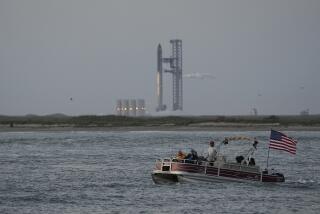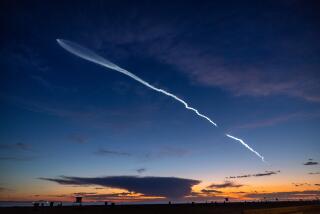THE SHUTTLE AND THE U.S. SPACE PROGRAM
- Share via
Tuesday, the day after Discovery is scheduled to land at Edwards Air Force Base, is the 31st anniversary of space flight. On Oct. 4, 1957, the Soviets launched the 184-pound Sputnik into orbit and initiated three decades of intense activity that, by the end of 1987, included 2,979 successful launches throughout the world, 117 of them manned. Competition between the U.S. and the U.S.S.R. for space leadership was especially intense, with the U.S. focusing first on a manned landing on the moon, then on the unmanned exploration of the solar system. In contrast, the Soviet Union concentrated on placing satellites in near-Earth orbit (2,017 successful launches compared to 878 for the U.S.) and on manned space flight (121,314 crew-hours compared to 42,453 for the U.S.). The U.S. space program reached its highest point in 1969, when Neil A. Armstrong first walked on the moon, then it suffered through a six-year period without manned spaceflight between the Apollo-Soyuz mission and the launch of the shuttle. The program reached its nadir in the period 1986-88, following the Challenger explosion. While the U.S. had a high of 73 successful rocket launches in 1966, there were only six in 1986 and eight in 1987. Among the highlights and the difficulties of the U.S. space program:
Jan. 31, 1958: U.S. launches first satellite, Explorer.
May 5, 1961: First American in space, Alan B. Shepard Jr.
Feb. 20, 1962: First American in orbit, John Glenn.
Jan. 27, 1967: Three Apollo astronauts die in fire on launch pad during training.
Dec. 21, 1968: First manned flight to orbit the moon.
July 16, 1969: First manned landing on the moon.
Jan. 5, 1972: President Richard M. Nixon authorizes development of space shuttle.
July 15, 1975: Launch of Apollo-Soyuz mission, the first docking of U.S. and Soviet spacecraft and the last manned U.S. spaceflight before the shuttle.
Sept. 17, 1976: Final assembly of shuttle orbiter Enterprise begins. Tests, including landings at Edwards Air Force Base, continue through 1977.
Dec. 17, 1979: Engines of shuttle orbiter Columbia pass first test firing at Kennedy Space Center.
April 12, 1981: First test flight of the National Space Transportation System. Shuttle orbiter Columbia with astronauts John W. Young and Robert L. Crippen.
Nov. 11, 1982: Fifth flight. Shuttle declared ready for use. First flight with mission specialists.
June 18, 1983: Seventh flight. First American woman astronaut, Sally K. Ride.
Aug. 30: Eighth flight. First black astronaut, Guion S. Bluford Jr. First night launch and night landing. First animals along, six rats.
Feb. 3, 1984: Tenth flight. First untethered spacewalks, using manned maneuvering units. First landing in Florida.
April 6: Eleventh flight. First repair of a satellite in space, Solar Max.
Nov. 8: Fourteenth flight. First recovery of malfunctioning satellites from orbit.
Nov. 26, 1985: Twenty-third flight. First assembly of structures in space.
Jan. 28, 1986: Twenty-fifth flight. At 73 seconds after launch, an explosion caused the loss of Challenger and its crew of seven.
Feb. 3: President Reagan appoints an independent commission, headed by William P. Rogers, to investigate the disaster.
April 18: Titan 34-D, carrying a military payload, explodes five seconds after launch from Vandenberg Air Force Base.
May 3: A Delta rocket, carrying a $57-million weather satellite, loses power 70 seconds after launch, veers out of control, and must be destroyed.
June 9: The Rogers Commission blames the shuttle disaster on a faulty O-ring in the solid rocket booster that allowed hot gases to escape and ignite the main fuel tank. The report also criticizes the launch decision and NASA’s history of ignoring problems with the boosters.
Aug. 12: NASA announces new booster rocket design with third O-ring added.
Aug. 15: President Reagan approves construction of a new shuttle orbiter.
March 26, 1987: An Atlas-Centaur rocket carrying a military communications satellite is launched during an electrical storm, goes out of control, and is destroyed.
Aug. 30: Redesigned booster rocket is successfully tested at Morton Thiokol’s Utah facility.
Oct. 26: Air Force successfully launches Titan 34-D carrying a military satellite.
Dec. 23: Part of the redesigned booster rocket breaks off during test firing.
May 4, 1988: Explosions level Henderson, Nev., plant of Pacific Engineering, one of two U.S. manufacturers of a key component of the booster rocket’s fuel.
June 21: The 600-day overhaul of Discovery is complete and it is ready to be mated to fuel tank and booster rockets.
July 4: Discovery is moved to launch pad.
Aug. 10: Main engines of Discovery successfully test fired.
More to Read
Sign up for Essential California
The most important California stories and recommendations in your inbox every morning.
You may occasionally receive promotional content from the Los Angeles Times.










